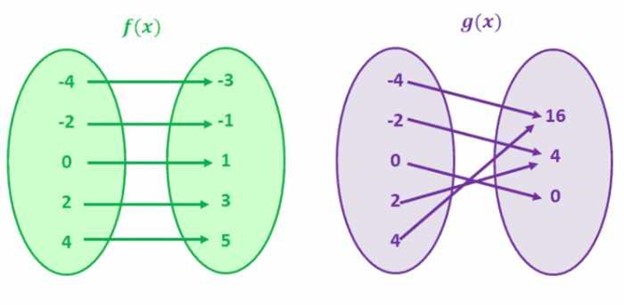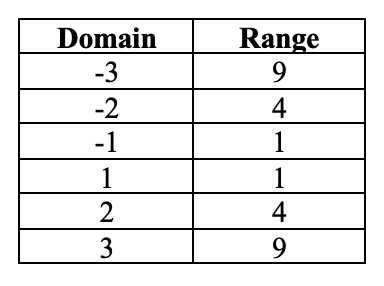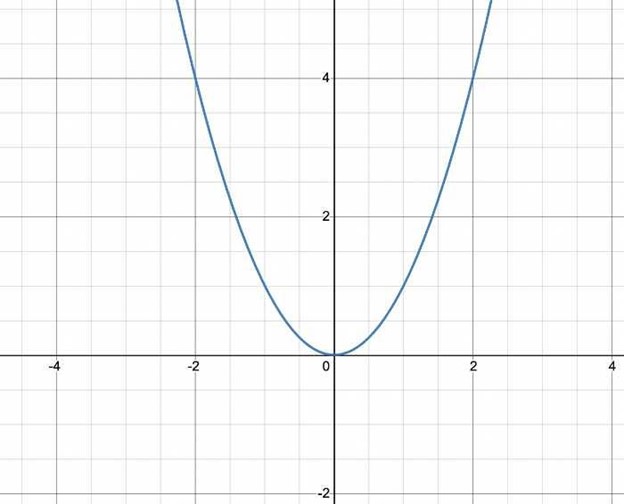One to One Functions - Graph, Examples | Horizontal Line Test
What is a One to One Function?
A one-to-one function is a mathematical function where each input corresponds to a single output. In other words, for every x, there is a single y and vice versa. This implies that the graph of a one-to-one function will never intersect.
The input value in a one-to-one function is noted as the domain of the function, and the output value is noted as the range of the function.
Let's look at the examples below:

For f(x), each value in the left circle correlates to a unique value in the right circle. Similarly, every value on the right correlates to a unique value on the left side. In mathematical words, this implies every domain holds a unique range, and every range holds a unique domain. Hence, this is a representation of a one-to-one function.
Here are some other examples of one-to-one functions:
-
f(x) = x + 1
-
f(x) = 2x
Now let's examine the second image, which shows the values for g(x).
Be aware of the fact that the inputs in the left circle (domain) do not have unique outputs in the right circle (range). For example, the inputs -2 and 2 have identical output, i.e., 4. Similarly, the inputs -4 and 4 have identical output, i.e., 16. We can discern that there are equivalent Y values for many X values. Hence, this is not a one-to-one function.
Here are some other examples of non one-to-one functions:
-
f(x) = x^2
-
f(x)=(x+2)^2
What are the properties of One to One Functions?
One-to-one functions have the following qualities:
-
The function has an inverse.
-
The graph of the function is a line that does not intersect itself.
-
The function passes the horizontal line test.
-
The graph of a function and its inverse are the same with respect to the line y = x.
How to Graph a One to One Function
To graph a one-to-one function, you are required to find the domain and range for the function. Let's examine a straight-forward example of a function f(x) = x + 1.

Once you possess the domain and the range for the function, you need to plot the domain values on the X-axis and range values on the Y-axis.
How can you evaluate whether or not a Function is One to One?
To prove whether a function is one-to-one, we can leverage the horizontal line test. Immediately after you plot the graph of a function, draw horizontal lines over the graph. If a horizontal line moves through the graph of the function at more than one place, then the function is not one-to-one.
Because the graph of every linear function is a straight line, and a horizontal line doesn’t intersect the graph at more than one point, we can also deduct all linear functions are one-to-one functions. Keep in mind that we do not use the vertical line test for one-to-one functions.
Let's examine the graph for f(x) = x + 1. Once you graph the values to x-coordinates and y-coordinates, you need to examine whether a horizontal line intersects the graph at more than one place. In this case, the graph does not intersect any horizontal line more than once. This means that the function is a one-to-one function.

Subsequently, if the function is not a one-to-one function, it will intersect the same horizontal line more than one time. Let's study the diagram for the f(y) = y^2. Here are the domain and the range values for the function:

Here is the graph for the function:

In this example, the graph intersects various horizontal lines. For instance, for either domains -1 and 1, the range is 1. In the same manner, for each -2 and 2, the range is 4. This signifies that f(x) = x^2 is not a one-to-one function.
What is the opposite of a One-to-One Function?
As a one-to-one function has a single input value for each output value, the inverse of a one-to-one function is also a one-to-one function. The inverse of the function essentially reverses the function.
Case in point, in the example of f(x) = x + 1, we add 1 to each value of x in order to get the output, i.e., y. The inverse of this function will subtract 1 from each value of y.
The inverse of the function is f−1.
What are the properties of the inverse of a One to One Function?
The characteristics of an inverse one-to-one function are no different than all other one-to-one functions. This means that the reverse of a one-to-one function will possess one domain for every range and pass the horizontal line test.
How do you determine the inverse of a One-to-One Function?
Figuring out the inverse of a function is simple. You just need to switch the x and y values. Case in point, the inverse of the function f(x) = x + 5 is f-1(x) = x - 5.

Considering what we discussed earlier, the inverse of a one-to-one function reverses the function. Considering the original output value required us to add 5 to each input value, the new output value will require us to delete 5 from each input value.
One to One Function Practice Examples
Consider the following functions:
-
f(x) = x + 1
-
f(x) = 2x
-
f(x) = x2
-
f(x) = 3x - 2
-
f(x) = |x|
-
g(x) = 2x + 1
-
h(x) = x/2 - 1
-
j(x) = √x
-
k(x) = (x + 2)/(x - 2)
-
l(x) = 3√x
-
m(x) = 5 - x
For each of these functions:
1. Determine if the function is one-to-one.
2. Plot the function and its inverse.
3. Find the inverse of the function algebraically.
4. Indicate the domain and range of each function and its inverse.
5. Employ the inverse to solve for x in each equation.
Grade Potential Can Help You Master You Functions
If you are struggling trying to learn one-to-one functions or similar topics, Grade Potential can set you up with a 1:1 tutor who can support you. Our Pembroke math tutors are experienced professionals who help students just like you advance their understanding of these subjects.
With Grade Potential, you can study at your individual pace from the comfort of your own home. Book an appointment with Grade Potential today by calling (954) 448-7531 to get informed about our educational services. One of our representatives will contact you to better determine your requirements to find the best tutor for you!




